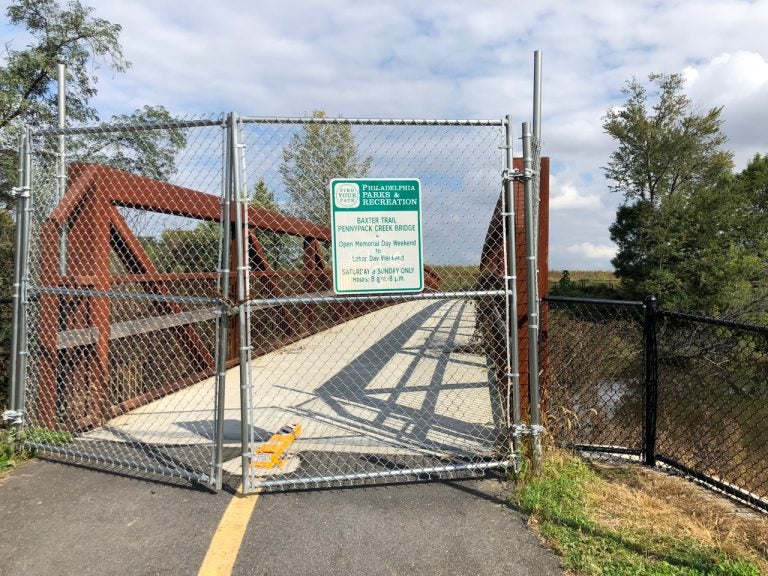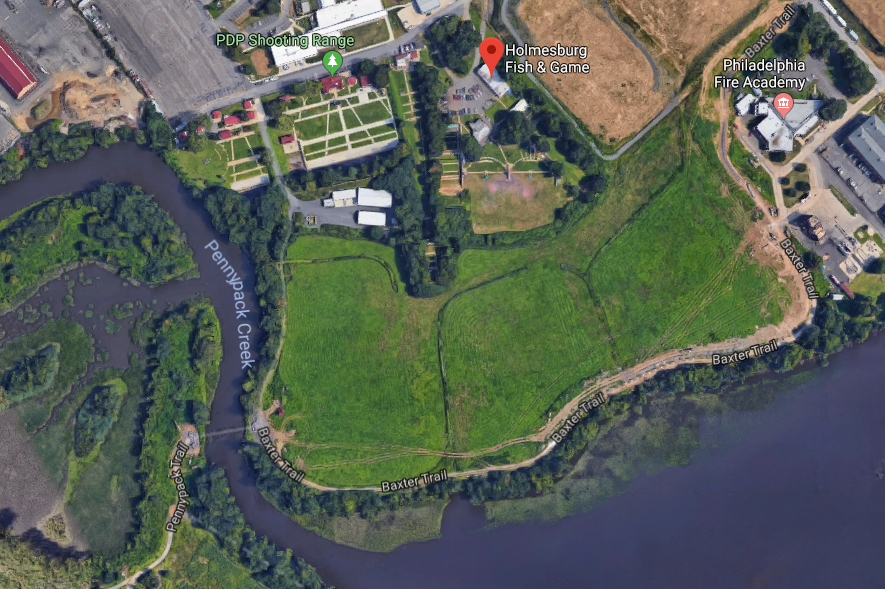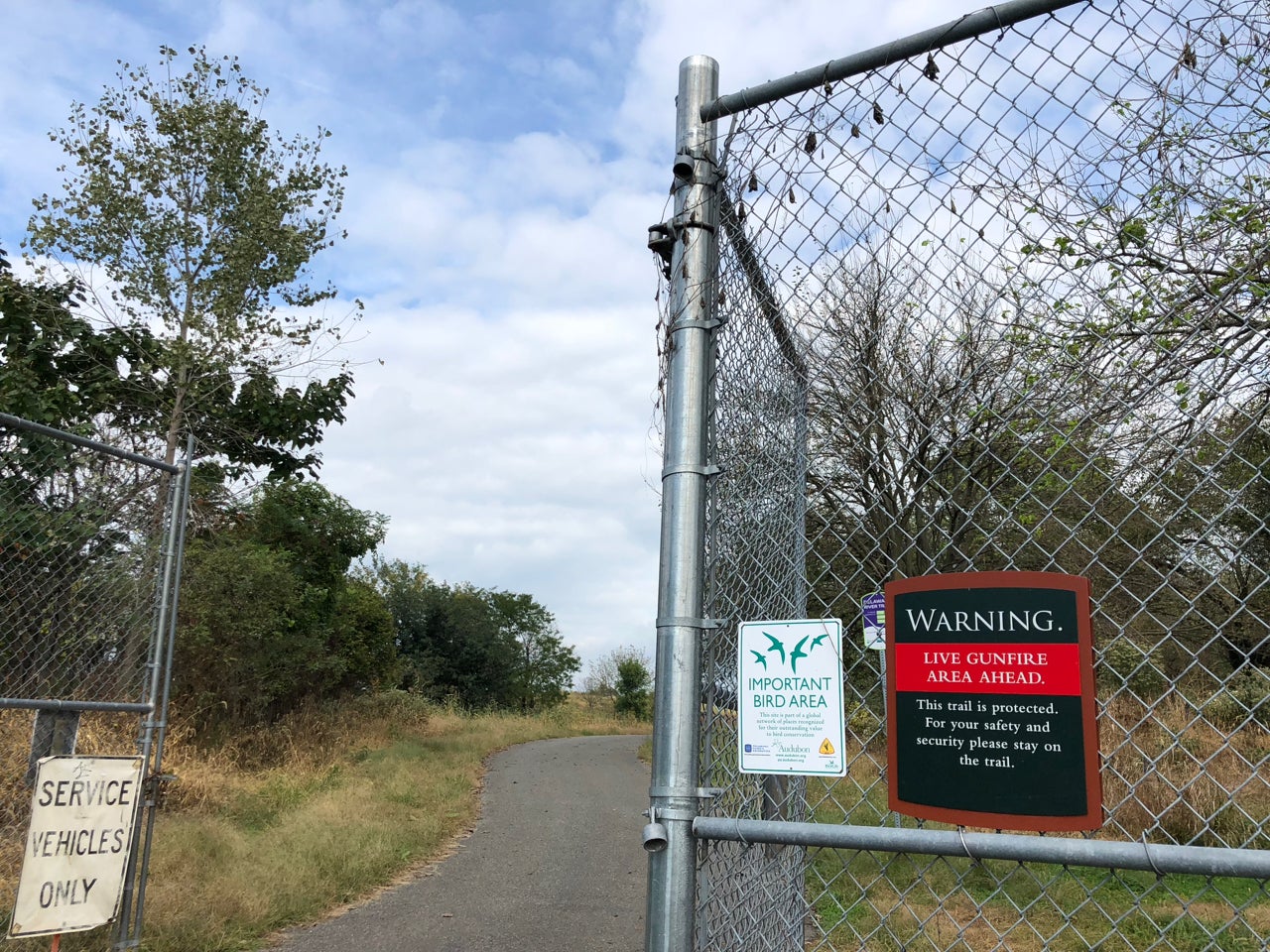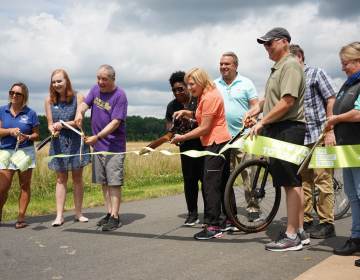Riding the (firing) range: Gunfire keeps new Delaware River trail closed
Standing in Pennypack where the trail opens, the crack of gunfire can often be heard in the distance.

A locked gate bars entrance to a bridge over Pennypack Creek on the Baxter Trail, at the north edge of Pennypack on the Delaware. (Meir Rinde for WHYY)
This story originally appeared on PlanPhilly.
—
Mountain biker Stan Needle is a devotee of the Pennypack bike trail. He starts his rides on a rail-to-trail route near his home in Bryn Athyn, enters Pennypack Park, and traces the curves of Pennypack Creek as it ambles southeast. The path snakes down a green swath of parkland through Bustleton, Rhawnhurst, and Holmesburg, where the route splits off to the south before the creek empties into the Delaware River.
Cyclists can continue on through Pennypack on Delaware Park along the river, following a scenic trail that runs along the Delaware’s edge and across a small bridge over the end of Pennypack Creek, before continuing to Pleasant Hill Park and points further north. Or at least they should be able to.
For most of the past two years, a locked gate across the trail has forced them to stop and turn around — preventing them from reaching the bridge and points beyond.
“As many times as I’ve gone down there, it’s never been open,” Needle said. He runs the Pennypack Park Trail Advocates, a volunteer advocacy group. “It’s frustrating. This trail, I’m looking at it like it’s candy hanging in front of me that I can’t have,” he said.
The closed path is part of the Baxter Trail, a 1.8-mile greenway that the Philadelphia Parks and Recreation Department completed in January 2016. Created as part of a decades-long initiative to give the public access to the North Delaware River waterfront, the trail occupies a narrow strip of land between the river and two active properties. The problem: They both happen to have active gun ranges.
Standing in Pennypack where the trail opens, the crack of gunfire can often be heard in the distance, booming reminders of the two facilities — a Philadelphia Police Department shooting range and a private shooting club.
The city commissioned two studies to determine how to keep ricocheting bullets from making it over the ranges’ earthen berms and harming people strolling or cycling on the other side. But despite already spending $6.2 million in state funds to build the Baxter Trail and install safety features, including a 20-foot-high wall, the city has kept the path closed for most of the nearly two years since it was completed.
Officials are planning additional gun-range improvements that will cost an estimated $12 million and won’t be completed for at least another year, keeping the trail mostly off-limits to the public for the duration. Meanwhile, would-be trail users remain frustrated, and the operations of the adjoining gun ranges have taken a hit.
“The whole thing sounds like it should have been addressed when the trail was being put in,” Needle said.

“Routine” improvements not enough
Bicyclists, joggers, and walkers were able to use the full Baxter Trail this past summer, but only on weekends. On weekdays, the public was locked out of the most scenic part, a half-mile section that hugs the riverbank and offers verdant views of New Jersey across the water. The trail was shuttered after Labor Day and weekend access won’t resume until next May.
Sophia Pryszlak, president of the Friends of Pleasant Hill Park, said her group has for years been asking the city to maintain access through the trail’s northern entrance.
“There’s a gate there that we’ve been begging them to keep open, but as of right now, their estimated opening date isn’t until the spring,” Pryszlak said. “That gate, once opened, takes you through the back of Pennypack on the Delaware — that’s where the bird sanctuary is, where the eagles nest — and then you hit the park.”
The long delay in fully opening the trail stems from the city’s handling of the safety studies. Mike Carroll, deputy managing director of the city’s Office of Transportation, Infrastructure, and Sustainability (OTIS), said the Department of Public Property (DPP) commissioned an initial study while the trail was being built and concluded that “pretty routine improvements” to the firing ranges would suffice. Later, someone in the city government decided those were not enough, and the department ordered up another study, he said.
“There was some concern that we probably should do something more substantial … and in fact, when we did do that second study, it did indicate that there was more work that was warranted,” Carroll said. OTIS and DPP turned down PlanPhilly’s request for copies of the studies.
Kevin Kubacki, president of the Holmesburg Fish & Game Protective Association (HF&G), the shooting sports club next to the trail, said he’s seen both studies, which were written by range safety experts contracted by DPP. Even the first study called for extensive safety measures to protect trail users from any possibility of harm, but the city did not follow all the recommendations, he said.
“I don’t know why they didn’t implement the first study,” Kubacki said. “There isn’t a whole lot of difference between the two studies. They’re both talking about spending tens of millions of dollars. The lion’s portion of the money is for the police ranges.”
Kubacki said it’s possible that the city initially balked at the high cost. OTIS said the city spent an additional $864,197 to design safety improvements and estimates the gun-range improvements will cost $12 million, though not all the work is related to trail safety. The city plans to “make enhancements to the range regardless of the trail,” the city said in an email. Construction is set to begin in fall 2019.
In addition to berms, common gun range safety features include baffles, which are barriers designed to keep bullets from leaving a range, and eyebrows, a type of sloped baffle at the top of a berm. The city previously built the 20-foot high wall and a chain-link fence topped with concertina wire between the ranges and the trail, Kubacki said. The range safety experts also recommended security measures such as surveillance cameras to keep people from sneaking into the police facility, he said.
Kubacki, whose club leases its property from the city, said he was last briefed on the safety alterations at a May meeting attended by officials from several city agencies. The city allowed the shooting sports club to continue using its indoor pistol range during summer weekends because it is adequately shielded. But the club’s outdoor range and the Police Department’s several ranges were ordered closed on those days, he said.
Kubacki said that two years ago the city was saying the safety work would be done by now, whereas now they expect it will take up to another two years. Carroll said DPP has to wait until the water department finishes part of a large basin construction project behind the HF&G property. It also has to accommodate the Police Department’s need to keep its ranges available for training activities as part of an agreement with the federal Department of Homeland Security.
Kubacki said he understands that cyclists and joggers want to use the trail on summer weekends, but the prospect of waiting years for the safety improvements is creating serious problems for the club.
“We have seen a decline in our membership, because people are paying to use the ranges when they have free time. That’s primarily on the weekends, and summer is prime time,” he said.
He noted that the 88-year-old club is the only outdoor shooting range open to the public in Philadelphia and is regularly used by police and corrections officers, Navy personnel, Housing Authority police, and other law enforcement agencies, in addition to club members. According to a history posted on HF&G’s website, the club was founded in 1930 with help from Samuel Baxter, the renowned civil engineer, and Philadelphia public works administrator after whom the Baxter Trail is named.

Creating green amid the gray
While gun ranges have unique safety issues, they’re just one of many challenges faced by those creating green spaces in a densely urbanized, semi-industrial landscape.
The North Delaware River Greenway Master Plan envisions 11 miles of connected trail segments and parks from Pulaski Park, at the end of East Allegheny Avenue in Port Richmond, up to the Glen Foerd on the Delaware estate. The nonprofit Delaware River City Corporation (DRCC), also known as Riverfront North, has been shepherding the work along since 2005. The organization has celebrated several successful projects — the Port Richmond Trail, the Delaware Avenue Extension, the K&T Trail, and Lardner Point Park — and is planning a new 10-acre riverfront park in Bridesburg.
But the greenway will never run continuously along the riverbank, even in the most optimistic projections. Shipping terminals, recycling and salvage centers, various other private companies, housing developments, the city’s prisons, and other municipal uses already occupy much of the land, making safe recreational access impossible in certain areas.
As a consequence of that development, most of Baxter Trail is not on the river’s edge. Beyond the northern gate, it turns inland and runs along relatively uninviting stretches of Pennypack Street and State Road in order to get around a city water treatment plant and riverside intake basin where public access is barred by federal regulations.
That kind of compromise is worth it, though, to allow residents of North Philadelphia to experience their natural environment after many decades of having it erased or obscured by development, said Stephanie Phillips, Riverfront North’s executive director.
“I really do think we’re fulfilling, in many ways, an unrecognized need up here. We’re trying not only to fulfill it but get the need itself recognized,” she said. “People need their green spaces and need to access their rivers here. It’s a challenge but it’s kind of wonderful, and I actually love the juxtaposition of the industry and the natural.”
Among the few people who have been able to stroll the full Baxter Trail recently are officials from Riverfront North and OTIS. Carroll said he was there earlier this month as part of a group that started at the normally off-limits Pennypack Creek bridge and walked up to the north gate, behind HF&G, before turning back.
“It’s beautiful. It’s very impressive,” Carroll said. “That is something we want to make available as a resource to everybody in the city, and as much as we can do that during the course of a year, that’s all good. We’ve made a commitment to finishing the trail project and we’ve identified the funding sources. It’s just a matter of getting the work done.”
WHYY is your source for fact-based, in-depth journalism and information. As a nonprofit organization, we rely on financial support from readers like you. Please give today.







